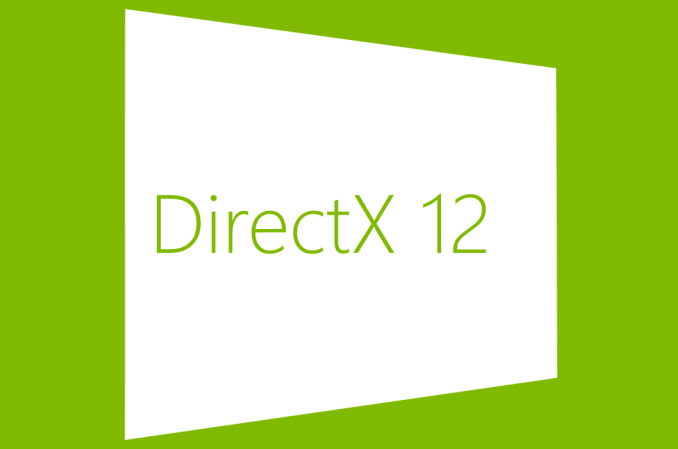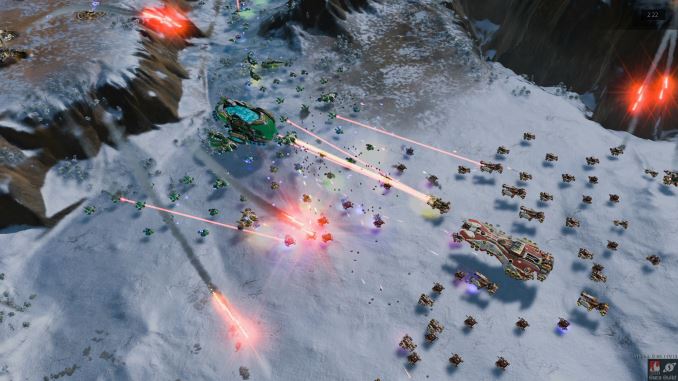Ashes of the Singularity Revisited: A Beta Look at DirectX 12 & Asynchronous Shading
by Daniel Williams & Ryan Smith on February 24, 2016 1:00 PM EST
We’ve been following DirectX 12 for about 2 years now, watching Microsoft’s next-generation low-level graphics API go from an internal development project to a public release. Though harder to use than earlier high-level APIs like DirectX 11, DirectX 12 gives developers more control than ever before, and for those who can tame it, they can unlock performance and develop rendering techniques simply not possible with earlier APIs. Coupled with the CPU bottlenecks of DirectX 11 coming into full view as single-threaded performance increases have slowed and CPUs have increased their core counts instead, and DirectX 12 could not have come at a better time.
Although DirectX 12 was finalized and launched alongside Windows 10 last summer, we’ve continued to keep an eye on the API as the first games are developed against it. As developers need the tools before they can release games, there’s an expected lag period between the launch of Windows 10 and when games using the API are ready for release, and we are finally nearing the end of that lag period. Consequently we’re now getting a better and clearer picture of what to expect with games utilizing DirectX 12 as those games approach their launch.
There are a few games vying for the title of the first major DirectX 12 game, but at this point I think it’s safe to say that the first high profile game to be released will be Ashes of the Singularity. This is due to the fact that the developer, Oxide, has specifically crafted an engine and a game meant to exploit the abilities of the API – large numbers of draw calls, asynchronous compute/shading, and explicit multi-GPU – putting it a step beyond adding DX12 rendering paths to games that were originally designed for DX11. As a result, both the GPU vendors and Microsoft itself have used Ashes and earlier builds of its Nitrous engine to demonstrate the capabilities of the API, and this is something we’ve looked at with both Ashes and the Star Swarm technical demo.
Much like a number of other games these days, Ashes of the Singularity for its part has been in a public beta via Steam early access, while its full, golden release on March 22nd is fast approaching. To that end Oxide and publisher Stardock are gearing up to release the second major beta of the game, and the last beta before the game goes gold. At the same time they’ve invited the press to take a look at the beta and its updated benchmark ahead of tomorrow’s early access release, so today we’ll be taking a second and more comprehensive look at the game.
The first time we poked at Ashes was to investigate an early alpha of the game’s explicit multi-GPU functionality. Though only in a limited form at the time, Oxide demonstrated that they had a basic implementation of DX12 multi-GPU up and running, allowing us to not only pair up similar video cards, but dissimilar cards from opposing vendors, making a combined GeForce + Radeon setup a reality. This early version of Ashes showed a lot of promise for DX12 multi-GPU, and after some additional development it is now finally being released to the public as part of this week’s beta.
Since that release Oxide has also been at work both cleaning up the code to prepare it for release, and implementing even more DX12 functionality. The latest beta adds greatly improved support another one of DX12’s powerhouse features: asynchronous shading/computing. By taking advantage of DX12’s lower-level access, games and applications can directly interface with the various execution queues on a GPU, scheduling work on each queue and having it executed independently. Async shading is another one of DX12’s optimization features, allowing for certain tasks to be completed in less time (lower throughput latency) and/or to better utilize all of a GPU’s massive arrays of shader ALUs.
Between its new functionality, updated graphical effects, and a significant amount of optimization work since the last beta, the latest beta for Ashes gives us quite a bit to take a look at today, so let’s get started.












153 Comments
View All Comments
extide - Wednesday, February 24, 2016 - link
If you are CPU limited, and it's using lots of threads, then yeah more cores would be faster. They were CPU limited on an overclocked 4960X, which is no slouch, that was very surprising!rhysiam - Wednesday, February 24, 2016 - link
I agree that will be very interesting. I'm surprised more hasn't been made of the seemingly pretty hard CPU limit to ~70fps, irrespective of the detail settings or resolution. And that on a still very capable 4960X @ 4.2Ghz. If we estimate Skylake has a 20% IPC advantage, that would still see the current top tier 6700K (at stock) maxing out in the mid 80s, a long way short of what you might like on a 144hz monitor. Does that mean a brand new quad core CPU like the i5 6400 with its low base clock might struggle to sustain 60fps, even on lower detail settings?I realise this is beta and all preliminary, but it's interesting nonetheless.
DanNeely - Wednesday, February 24, 2016 - link
Does DX12 Multi-adapter offer any benefits with cards that are mismatched in performance? I'm currently running a GTX 980 in my main PC and also have an older GTX 770 sitting around; would pairing them offer any speedup over just the 980, or would the faster card end up held back by the slower one?I'd be equally interested in seeing how AMD does with significantly mismatched GPUs; since they've been trying (with varying degrees of success) to push XFire between their IGPs and the significantly faster chips in midrange Radeon cards.
BigLan - Wednesday, February 24, 2016 - link
The article has a quote from the developer about using mismatched cards..."For example, you will never get more than twice the speed of the slowest video card. You would be better off just using the new card alone."
You might get some benefit, but likely not that much.
Friendly0Fire - Wednesday, February 24, 2016 - link
I think that's rather narrow minded and way too absolute. Mismatched cards can be used to their full potential, but you'd need some smart coding to make it so. For instance, you could offload some of the work to the weaker GPU, keeping the stronger one for the main rendering.One excellent example which would fully utilize two mismatched cards is VR: multiadapter rendering would be used to offload the VR projection and transformation steps to the integrated GPU in most modern CPUs, while the main GPU would do the regular rendering. The data transfer requirement is minimal, but there's a fair amount of computations required, making it an ideal scenario.
Other examples include doing post-processing on the weaker card (SSAO, subsurface scattering, screenspace reflections, etc.). The big problem is judging just how much work should be offloaded to the secondary GPU - just detecting the hardware would be extremely laborious.
Ryan Smith - Wednesday, February 24, 2016 - link
It's a correct description for how Ashes works. They implement a (relatively) straightforward AFR setup, so the cards need to be similar in performance.Senti - Wednesday, February 24, 2016 - link
What Multi-adapter does is left completely to developer. In some cases it can give you nothing, in others every bit of hardware can be useful including iGPU.extide - Wednesday, February 24, 2016 - link
Their current implementation is AFR, so the performance of the cards should be as close to identical as possible. In the future I think they may plan on offloading some of the raw compute onto a second GPU, and in that case an older slower GPU would be beneficial.Drumsticks - Wednesday, February 24, 2016 - link
These are always interesting results to see. I'm pretty excited for Polaris - I can't wait to pickup a higher end GPU to replace my old, old 7850.mattevansc3 - Wednesday, February 24, 2016 - link
Isn't Oxide's statement that they don't optimise for certain hardware a bit disingenuous?If you read their developer diaries not only was AoS built around Mantle, not only was the engine built upon Mantle but they've stated that they developed more of Mantle than AMD did.
Before DX12 was even announced Oxide were working directly with AMD and building AoS to champion Mantle and take advantage of it a low level while only supporting nVidia hardware on DX11. That of course will automatically bias results in favour of RTG even if there is no intention to do so at this stage.